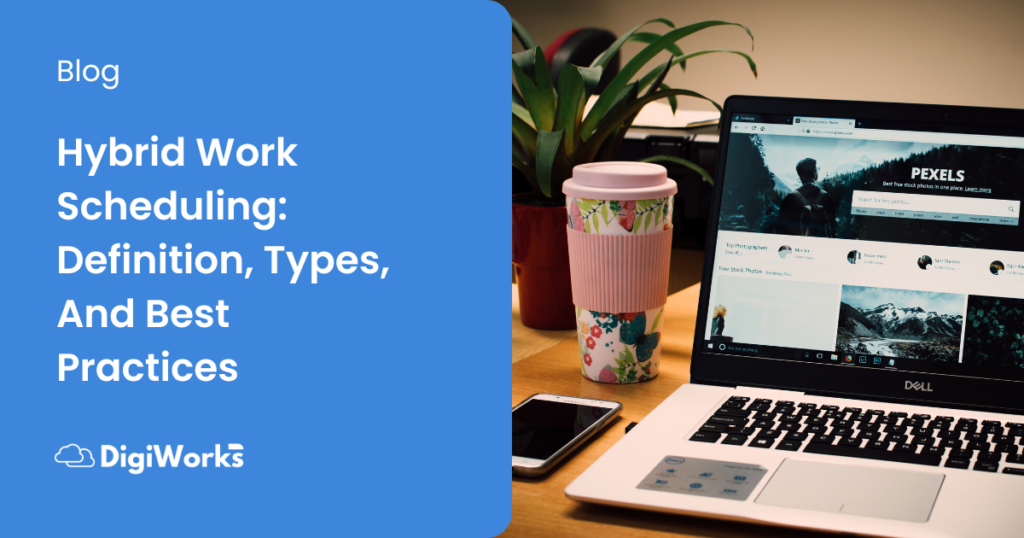Hybrid Work Scheduling: Definition, Types, And Best Practices
Jul 15, 2024 • 19 min read

The concept of a hybrid work model involves combining onsite and remote work to create a flexible work schedule that benefits both employees and employers. This type of work model has become increasingly popular in recent years, particularly in the wake of the COVID-19 pandemic, which forced many businesses to adopt remote work policies virtually overnight.
You’ll learn:
- What is a Hybrid Work Schedule?
- Why Hybrid Work isn’t Going any Time Soon
- Best Practices for Mastering the Hybrid Work Challenge
- Hybrid Work Schedules to Help you Get Started
- Best Practices for Offices that Focus on Hybrid
- How to Create Meaningful Connections in a Hybrid Work Setting
Ready to build your remote team?
Use the DigiWorks platform to hire, manage, and pay remote talent from all over the world.
What is a Hybrid Work Schedule?
The term “hybrid work schedule” refers to a work arrangement in which employees split their time between working from home and working in the office. This model has become increasingly common in recent years, as organizations seek to offer flexible work options that accommodate employees’ changing needs and preferences.
The COVID-19 pandemic has accelerated the adoption of hybrid work schedules, as many businesses were forced to rapidly shift to remote work to protect their employees’ health and prevent the spread of the virus. During this time, companies discovered that remote work is not only feasible, but also has the potential to increase productivity and lead to cost savings.
There are two main types of hybrid work schedules: office-centric and remote-first. In an office-centric model, employees typically spend most of their time working in the office and only work from home on occasion. This approach allows for collaboration and social interaction among employees, while still offering some flexibility.
On the other hand, a remote-first model prioritizes remote work as the default option, with employees only coming into the office on specific days or when necessary. This approach allows for greater flexibility and autonomy, and can be particularly attractive to employees who prioritize work-life balance and value the ability to avoid commutes and work from anywhere.
In conclusion, hybrid work schedules are a flexible and adaptable work arrangement that has become increasingly popular in recent years, particularly due to the pandemic and the need to provide employees with a safe and productive work environment. Whether the focus is on an office-centric or remote-first model, organizations that embrace a hybrid approach can better attract and retain top talent while improving productivity and employee satisfaction.
Why Hybrid Work isn't Going any Time Soon
As we continue to navigate the aftermath of the COVID-19 pandemic, hybrid work models have proven to be a popular and effective solution for organizations looking to balance the needs of their employees with those of the business.
One of the key factors contributing to the continued popularity of hybrid work models is the flexibility they provide. Employees can work remotely when needed, allowing them to better balance their work and personal responsibilities, resulting in a better work-life balance. Additionally, hybrid work models address the continued uncertainty around the safety of returning to the office, as many employees feel more comfortable working remotely.
However, implementing a hybrid work model can also come with its own set of challenges. For example, establishing clear communication and maintaining team cohesion can be difficult when employees are working both in the office and remotely. Similarly, there may be limited opportunities for career advancement for remote employees who are not physically present in the office environment.

Best Practices for Mastering the Hybrid Work Challenge
To make the most of a hybrid work model, it’s crucial for both employers and employees to adopt best practices that promote effective communication, collaboration, and accountability. In this section, we’ll discuss three key practices that have proven essential for mastering the hybrid work challenge: transparency, meaningful one-on-one meetings, and accountability. By implementing these practices, businesses can help ensure that all employees feel valued, engaged, and supported, whether working in the office or remotely.
Transparency
Transparency is a critical aspect of a successful hybrid work model as it fosters trust among team members and ensures that everyone is aware of how and where they can be reached. When working remotely, it’s easy to feel disconnected from the team, but with transparency, employees know what is going on and can participate in team activities, regardless of location.
To promote transparency, it’s crucial to ensure that schedules are equal among team members. This means that there’s no room for special treatment, and every employee has a fair and equal opportunity to work in the office or from home. Feedback loops are also essential to gather and process feedback from employees about their preferences regarding working arrangements and concerns they may have. By having regular feedback sessions, managers can identify areas where they need to make changes or address issues.
In addition to equal schedules and feedback loops, building a transparent culture and authentic relationships can strengthen trust. Personal time blocks can be used to allow employees to share their interests and personal life, which can help create authentic relationships. Clear communication is also key to creating a transparent culture. Employees should have access to all relevant information, including company updates, team meetings, and company events.
Meaningful 1:1 meetings
Conducting meaningful 1:1 meetings with employees is essential in a hybrid work schedule as it helps managers stay connected with their team members and address any concerns or issues that may arise. To conduct these meetings effectively, the manager should begin by asking for their employee’s preferences, key tasks, or feedback on this new work arrangement. This provides an opportunity to show that the company values the employee’s input and allows them to have an open conversation about their experiences in the hybrid work model.
It’s important to schedule specific times and dates for each meeting or use a meeting scheduler to set up impromptu meetings. These regular check-ins ensure that both the manager and the employee are aware of the meeting schedule and have enough time to prepare. Impromptu meetings also provide an opportunity for more frequent check-ins if needed.
During the meeting, the manager should actively listen to the employee and take note of any signs of burnout or issues they may be having. Encouraging open communication about work-related challenges can help prevent burnout and improve employee morale. The manager should also provide actionable steps to address any issues that may arise, whether it’s additional resources, changes in workload, or support in personal development.
To ensure that these meetings are indeed meaningful, managers should find time for at least one meeting each month with each employee they directly manage. This regular cadence of check-ins is crucial to building trust and cultivating authentic relationships. Keywords to keep in mind when conducting these meetings include meaningful, 1:1 meetings, hybrid work schedule, feedback, and burnout.
Accountability
Promoting accountability among employees in a hybrid work model can be challenging. On one hand, managers need to trust their employees to manage their workload and meet deadlines. On the other hand, there must be clear lines of communication and a framework for holding employees accountable.
To promote accountability, it’s crucial to regularly check in with your team and track their performance through project management software. Regular check-ins provide an opportunity for employees to ask questions, share progress, and receive feedback. It also allows managers to identify any challenges early on and offer support where necessary. Project management software is an effective tool for tracking the progress of your team’s projects while ensuring that everyone is on the same page.
Another way to promote accountability is to encourage employees to send daily reports on their work progress, attend weekly or monthly catch-up meetings, and set and meet KPIs. These practices show that employees are taking responsibility for managing their workload and meeting their goals. Additionally, setting clear expectations around reporting and ensuring that remote and on-site employees are held to the same standards will help promote accountability across the board.
As a manager, it’s essential to establish a culture of trust and accountability by clearly communicating expectations and holding employees accountable when necessary. Without a framework for accountability, it’s easy for employees to become disengaged or fall behind on their work. By encouraging open communication, tracking performance, and setting clear expectations, you can promote a culture of accountability that benefits both your team and your organization.

Hybrid Work Schedules to Help you Get Started
There are various hybrid work models, each with its own advantages and disadvantages. A cohort schedule involves dividing employees into distinct groups that alternate in-person and remote work days; a staggered schedule involves staggering employee arrival and departure times to reduce congestion in the office; and a flexible schedule gives employees more freedom to choose where and when they work. Which model is best for you depends on your company’s needs and employees’ preferences. In the following sections, we will explore each of these hybrid work schedule models in more detail.
Cohort schedule
One of the most common and effective ways managers implement a hybrid work schedule is through cohort schedules. In this model, employees are divided into groups or cohorts, with each cohort assigned specific days or weeks to work in the office.
Cohort schedules provide regularity and consistency for team members as they know which days they are expected to work in the office and when they can work from home. This consistency allows team members to plan their workloads more efficiently, making them more productive and reducing stress levels. Additionally, it also provides a sense of structure and routine which can be beneficial for individual employee well-being.
The standardization of cohort schedules is another of its advantages. With all team members following the same schedule, minimal office management and coordination is necessary, freeing up managers’ time to work on other essential tasks. This consistency also helps improve team communication and collaboration, as everyone is available to work together on their scheduled in-office days.
While there are several perks to cohort schedules, it is essential to note that they may not be suitable for all team members. Cohort schedules create a common rule set of in-office days that may not align well with the personal and professional responsibilities of individual employees. As such, in some cases, it may be necessary to make exceptions or offer alternative arrangements for specific team members.
Staggered schedule
Another popular hybrid work model is the staggered schedule. Unlike the cohort schedule, the staggered schedule is more flexible, allowing employees to work in the office at different times. In this model, employees can choose which days and hours they work, allowing for adaptive scheduling based on personal responsibilities or individual preferences.
The staggered schedule is particularly useful for large organizations with smaller office spaces, as it prevents overcrowding and enables the company to maintain social distancing protocols. Additionally, it offers greater flexibility to employees because they can adjust their in-office hours as needed and work outside typical business hours if necessary.
One potential drawback of the staggered schedule is that it may not provide the same level of consistency and routine as the cohort schedule. With different employees working at different times, it may be more difficult to coordinate meetings and collaboration efforts. Additionally, employees who are primarily remote workers may struggle to adjust to this model, as they may feel like they are not part of the in-office team.
Despite its drawbacks, the staggered schedule can be a suitable choice for certain organizations and teams, especially those with flexible work arrangements. For example, in industries where employees work independently but need to be in the office occasionally, such as in sales or marketing, the staggered schedule can provide the optimal balance of in-office and remote work.
Ready to build your remote team?
Use the DigiWorks platform to hire, manage, and pay remote talent from all over the world.
Flexible schedule
Flexible schedule is a hybrid work model that offers maximum flexibility to employees. In this model, employees have complete control over their work location and hours, which provides them with the freedom to balance their personal and professional life effectively. The flexible schedule model allows employees to work from any location, whether it’s at home or a coffee shop, as long as they can meet their work requirements.
One of the significant benefits of this model is that it improves employee satisfaction and work-life balance. The flexibility of choosing when and where to work gives employees more control over their schedules, allowing them to manage their time more effectively. This improved work-life balance can lead to reduced stress and higher job satisfaction.
However, the flexible schedule model also has its drawbacks. Bringing team members together for in-person meetings can be challenging, especially when they are not in the same location. Small workspaces may not be able to accommodate everyone, and it can be difficult to maintain personal interaction when employees are working remotely. Additionally, communication can become complicated if schedules are not aligned and organized, making it necessary to plan and coordinate carefully.
Despite the challenges, the benefits of flexible work arrangements cannot be ignored. Organizations that have successfully implemented the flexible schedule model have seen an increase in employee productivity, performance, and engagement. This model has also helped to attract and retain top talent, making it a popular choice for modern companies.
Which model is the best for you?
Choosing the right hybrid work model for your company is essential and requires careful consideration of various factors. As companies seek to find the perfect balance between remote and in-office work, it’s important to understand the unique characteristics of your organization, including management and employee preferences.
While the flexible schedule model allows for maximum autonomy for employees, it may not be ideal for every organization. A hybrid work policy that mixes and matches different models may better fit the needs of your company. In doing so, you can create a customized work model that best suits your organization.
When deciding on your hybrid work schedule, it’s important to ask specific questions, such as which days your team will work in the office versus remotely and what employee availability will be like. Answering these questions will facilitate a clear and concise hybrid work policy that ensures transparency and fosters trust among your team.
Explicitly outlining expectations and guidelines for your employees is also crucial. Being explicit helps to mitigate misunderstandings and ensures that everyone is on the same page. Taking the time to communicate a clear hybrid work model is an essential step in achieving organizational success.

Best Practices for Offices that Focus on Hybrid
To make the most of a hybrid work schedule, it’s important to establish best practices. These practices fall into various categories: from setting clear KPIs to investing in proper tools and enforcing a viable schedule. Here are the top three best practices for office environments that focus on hybrid work.
1. Set clear KPIs
When it comes to managing a hybrid work model, one of the most important tasks for managers is to set clear Key Performance Indicators (KPIs) for their team. KPIs are valuable metrics that can help you measure employee performance, productivity, satisfaction, and engagement in a remote work environment. By setting clear KPIs, managers can ensure that their team members know what is expected of them, and can focus their efforts on achieving their goals.
Establishing KPIs is especially important in a hybrid work environment because it helps managers track progress even when not everyone is in the office. Here are a few KPI examples that can be used to track the progress of hybrid employees:
- Task completion time: This measures how long it takes your team members to complete specific tasks. Tracking task completion time can help you identify any inefficiencies in your team’s processes and find ways to optimize their workflow.
- eNPS: Employee Net Promoter Score (eNPS) is a measure of employee satisfaction and engagement. This is determined by asking employees how likely they are to recommend the company as a place to work. Monitoring eNPS can help you identify any issues with employee morale and take steps to resolve them.
- Hybrid employee turnover rates: This KPI helps you track the number of hybrid employees who have left the company. High turnover rates could indicate that your hybrid work policies are not working as well as they should be.
- Adoption rates of new technical tools: This measures how well your team members are adapting to new technologies and tools. Tracking this KPI can help you identify any training needs and ensure that your team is using the best possible tools for their work.
It’s also important to define clear priorities and goals when setting KPIs. This will help your team align on the highest impact work and create plans to guide them towards success. You can use OKRs (Objectives and Key Results) or the SMART goal-setting method (Specific, Measurable, Achievable, Relevant, and Time-bound) to define clear goals and ensure that your KPIs are aligned with those goals.

2. Invest in proper tools
Implementing a successful hybrid work schedule requires investing in the proper tools that can help manage communication, collaboration, and productivity. As remote and on-site employees work together, efficient collaboration is crucial to ensure that everyone is on the same page. Therefore, investing in the right communication tools is essential.
In a hybrid work environment, a solid Work Operating System (Work OS) is also vital. A Work OS can help manage work, organize schedules, and better adapt to a hybrid model. It provides a single platform where your team can communicate, collaborate, and get work done. This software can also help you monitor your team’s progress and track tasks to completion.
When selecting a Work OS, it’s important to consider essential features such as visualizations, project management tools, reporting capabilities, collaboration features, and customizable options. With visualizations, you can view data in charts or graphs to help you better understand your team’s progress and performance. Project management tools can help you plan your projects, assign tasks, and set deadlines. Reporting capabilities can also provide insights into the progress of your team’s work and highlight areas that need improvement.
One example of a Work OS is monday.com, which offers over 200 pre-built templates for different use cases. monday.com is an easy-to-use platform that provides a visual overview of your team’s work, making it easier to manage workloads and communicate with team members. This platform is highly customizable, allowing your team to tailor it to their specific needs, and its project management tools help you stay on top of tasks and deadlines.
3. Establish schedules (and stick to them)
One of the essential aspects of implementing a successful hybrid work schedule is establishing clear and structured schedules for all employees, regardless of their location. When both remote and on-site employees know when their work hours are and what is expected of them, they can produce their best work and avoid misunderstandings. Setting schedules not only provides clarity on expectations, but it also fosters an environment of productivity and accountability.
There are several types of hybrid schedules an organization can consider: cohort schedules, staggered schedules, and flexible schedules. Cohort schedules involve dividing teams into groups that work in alternating periods of time. Staggered schedules, on the other hand, require employees to work at different times to reduce the number of employees working on-site. Finally, flexible schedules allow employees to work their hours that best fit their personal and professional needs.
It is essential to stick to established schedules, as this maintains employee productivity and ensures that the workflow is consistent. However, it is crucial to note that while structured schedules are essential, over-managing employees can lead to a loss of engagement. Micromanaging can make employees feel like they are not trusted and can even create confusion about what is expected of them.
Instead, employers should strive to build trust with remote and on-site employees by providing them with the necessary resources to be productive. Managers should focus on outcomes and deliverables instead of monitoring every movement of their employees. This approach creates a positive working environment where employees feel empowered and engaged.
How to Create Meaningful Connections in a Hybrid Work Setting
Creating meaningful connections amongst a distributed team can be challenging, but with the right tools and mindset, it’s possible to keep your remote and on-site employees engaged and motivated. One of the most important things to do is to introduce tools that will help keep your team connected and engaged with one another.
Another way to keep your team connected is by incorporating your favorite communication tools into your hybrid workflow. This can make conversations engaging and help you stay connected with your employees without disturbing their workflows or tying them into lengthy meetings. With so many options for communication tools available, it’s essential to find ones that your team enjoys using and that work well with your hybrid environment.
While work is essential, it’s equally important to provide opportunities for team members to socialize and bond through virtual team-building activities. Hosting virtual happy hours or online games is a great way to bring your team together and build stronger connections amongst team members.

Conclusion
The bottom line is that remote workers are no different than anyone else. They still require the same basic workplace skills such as communication, collaboration, problem-solving, leadership, planning, and decision-making. But they also need to possess certain traits specific to remote workers. For example, remote workers must be comfortable multitasking, self-motivated and flexible.
To ensure that you hire the best candidates for your team, consider hiring someone who already works remotely. You’ll save yourself the hassle of training and onboarding them. And if you decide to go down the remote route, make sure you offer flexibility and transparency throughout the process.
Remote workers are an important part of a growing number of businesses. They help employees work faster, improve customer experience, and save money. If you’re not sure where to start when it comes to hiring one, DigiWorks is an amazing solution. The DigiWorks team will connect you with a global talent pool so you can find someone who is a great fit for you and your business!
Ready to build your remote team?
Use the DigiWorks platform to hire, manage, and pay remote talent from all over the world.
About DigiWorks
DigiWorks is an easy-to-use platform that helps small businesses and start ups hire amazing remote talent from around the world. DigiWorks offers a way for you to hire, manage and pay people from all countries. If you find an amazing virtual assistant from Philippines, a content writer from Nigeria, or operations manager from South Africa – manage and pay your entire team from one platform with no hassle.
If you’re looking for a more affordable and sustainable option you might consider making use of a hiring platform like DigiWorks. Virtual assistant companies or platforms like DigiWorks are amazing as they not only match you with pre-vetted and assessed remote workers that can take care of all your business needs but they will also handle all onboarding and payroll needs as well.



